
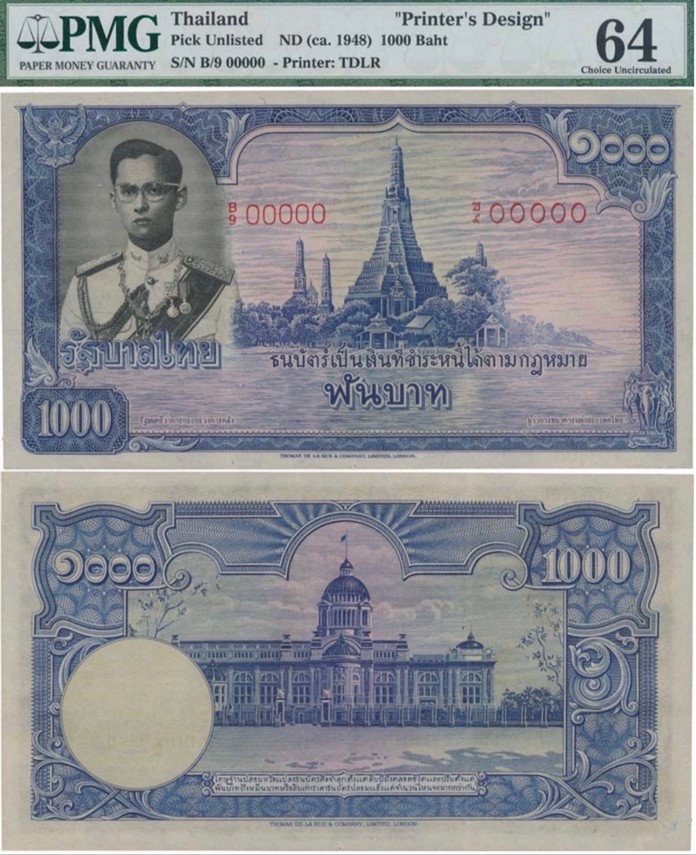
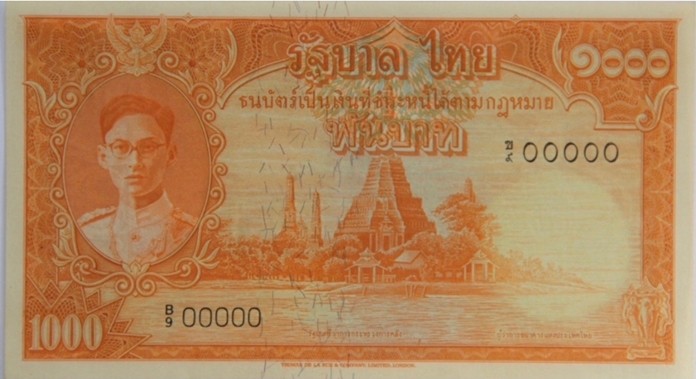
In last issue of the Pattaya Mail, Friday November 20-December 2, 2020 I wrote about the 1000 Baht 1949-1952 printed By Thomas de la Rue & Company Limited London (TdlR).
In 2015 other types and colours of the 1000 Baht turned up in the market. At TdlR in England there was no information nor similar notes in their archives. There were rumours that the notes had been printed as “Printers Designs” or “Colour Trials” at the Thomas de la Rue Company on Campbell Road, Rangoon, Burma. In Burma TdlR had been printing Thai 1-, 5-, 10- and 20 Baht notes. The background of the notes was printed on watermarked paper in England and shipped to Burma where the intaglio printing took place.
In 1948, the Bank of Thailand ordered a halt of all production of their banknotes at TdlR in Burma for several reasons. While awaiting destruction, workers had stolen the notes. There was no direct shipping from Rangoon to Bangkok so the notes had to be delivered via Singapore.
This was unacceptable as it represented a risk of loss. Shortly after, TdlR closed down the production in Burma and sent the press back to Bombay, India, and returned the paper, ink, printing plates and some already printed notes to the head office in England.
After Thomas de la Rue in Rangoon moved out, the premises became a private residence of the Law-Yone family. Ed Law-Yone, editor & publisher of The Nation newspaper in Burma used the ground floor as offices and for printing of his newspaper. One of the old TdlR presses had been sold to The Nation. It is not likely that TdlR in Burma printed the new appearing notes.
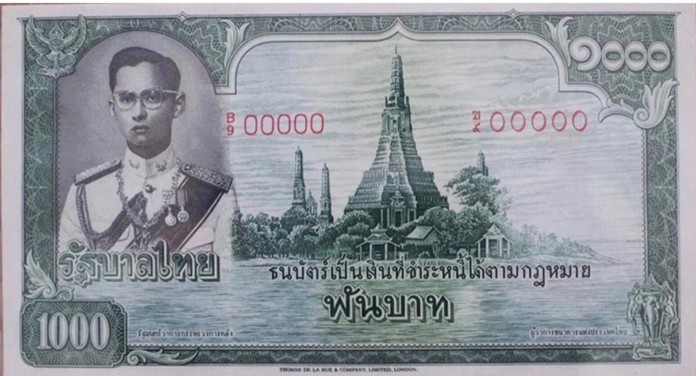
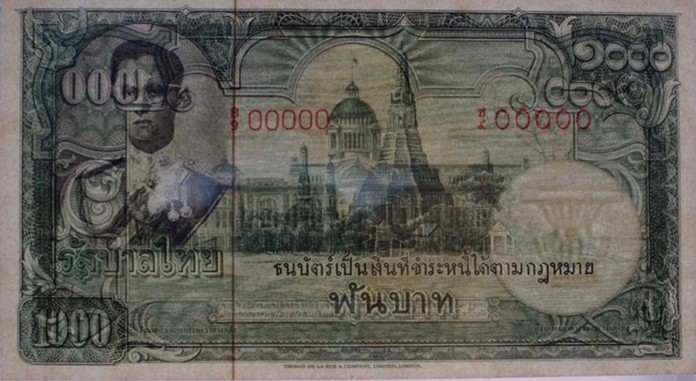
The prices for the “new” notes appearing in the market in 2015 were valued from 900,000 Baht up to 1,350,000 Baht. There are two different types with some of the notes being printed only on the obverse side. They were offered for lower prices of around 500,000 Baht.
In August of 2016, notes printed on both sides were offered in the Eur-Seree auction with a starting price of 700,000 Baht and 450,000 Baht but did not find any buyers. In December of 2016, a one-sided note was offered in the Eur-Seree auction with a starting price of 300,000 Baht and sold for 330,000 Baht. In August of 2020, a note printed on both sides had a starting price of 240,000 Baht and sold for 250,000 Baht.
Several notes are also sold privately, not at auctions. The lowest price that was offered to me for these notes was 200,000 Baht, but so far, I have not included these newly appeared notes in my collection even though I do collect Thai TdlR artwork, photogravure, printer’s designs, colour trials and specimen banknotes. I feel much more confident with the notes which have been sold and from the archives of TdlR, London and previously used as samples with prefix A/5. The ones which were kept as samples by the Bank of Thailand and the one with prefix A/1 sold for 1,500,000 Baht.
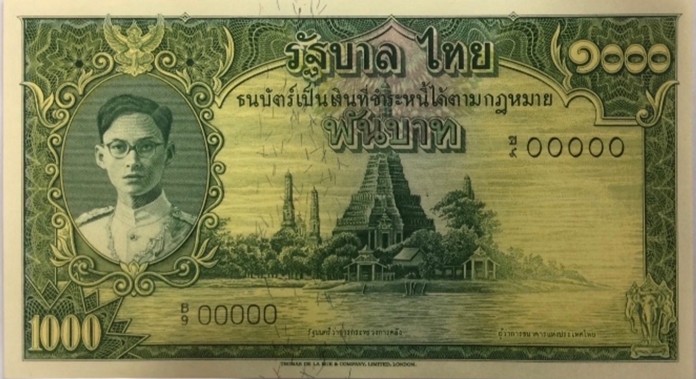
One of the types of the new appearing notes reminds me about the one printed by TdlR in London. The other has the portrait of King Bhumibol Adulyadej, Rama IX, inside a round frame with the Garuda above the portrait. All the notes have the prefix B/9 and the number 00000, one 0 less than those printed by TdlR in England. This prefix was used on the 10-, 20-, 100- and 1000 Baht specimen which were the never issued Bat Tannakarn banknotes. Prefix B/9 was also used on the 100 Baht Ninth Series Type I.
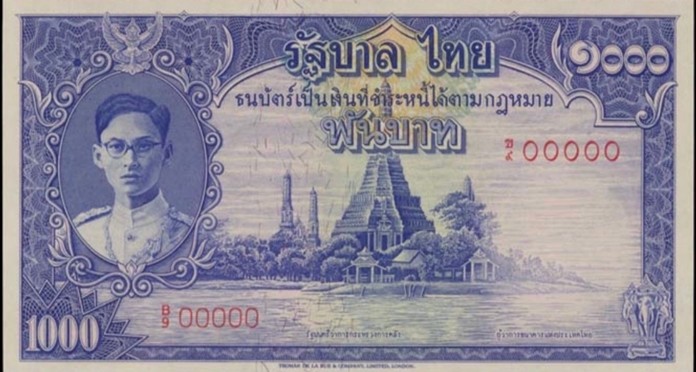
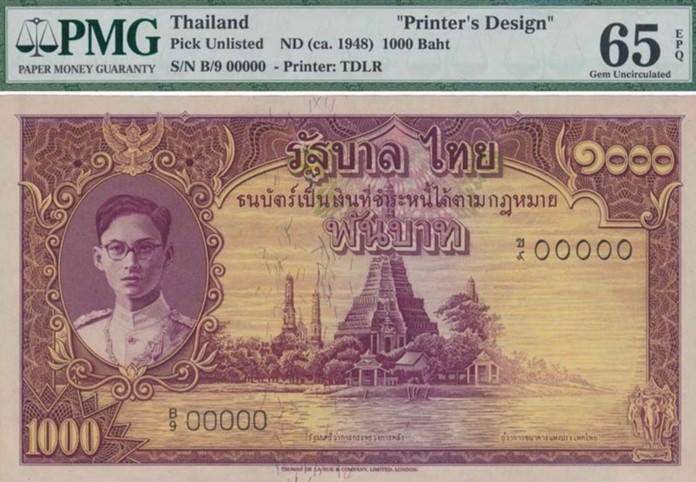
Both types are printed in several colours. Some of the notes with the portrait inside the circle does have a red prefix and numbering, others black.
Initially, when these notes appeared in the market, both types and several colours were for sale. There were no duplicates, except for some with printing on the obverse only. It was claimed that there was only one of each for sale. Later duplicates mysteriously appeared on the market and were for sale. It is claimed that someone has a large stash of these banknotes and is slowly selling them. I have seen collections with 10 or more of these recently appeared notes.
TdlR, London did produce the artwork, photogravure, archival photographs, printer’s designs, and prints from the main front plate, colour trials, and specimen notes. Artwork could be produced in very limited numbers. One or two archival photographs, a few prints from the main front plate in connection with minor changes, printer’s designs and colour trials could be produced for the customer and could be used as samples for other customers, specimen notes for the customer, as samples and for other national banks to inform them about the current circulating banknotes. At the time, specimen notes were rarely sold commercially to collectors.
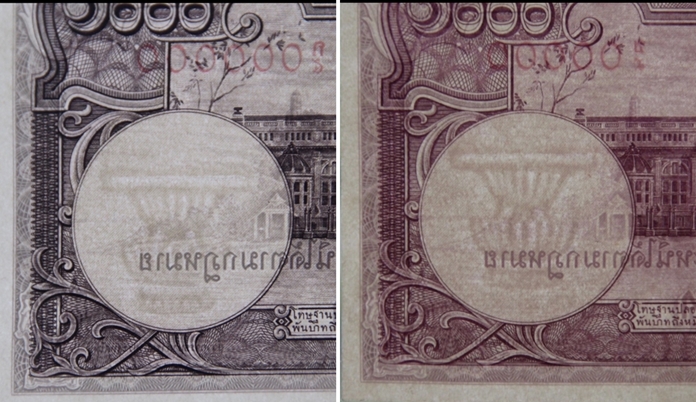
The watermark of the ones from the archives of TdlR is in a different position, lower down in the circle, first picture. At this time the watermarked paper was produced in England and part of the printing took place in England. If printed abroad the watermark should be in the same position. With banknotes it is always interesting for collectors to know the circumstances and background of a banknote. With these newly appeared banknotes, which apparently were printed 65 years ago, there should at least be some references somewhere. It seems like somebody is keeping his or her cards or rather banknotes close to their chest.
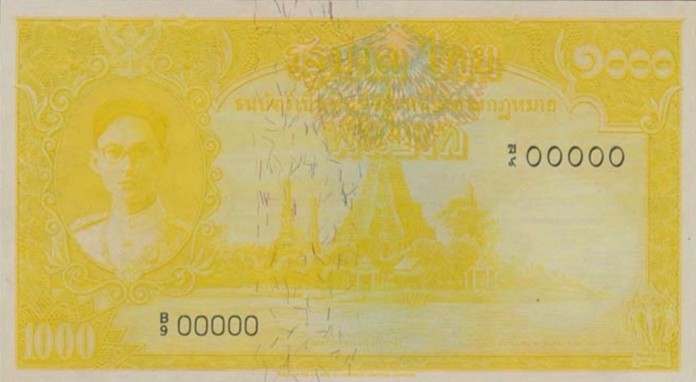
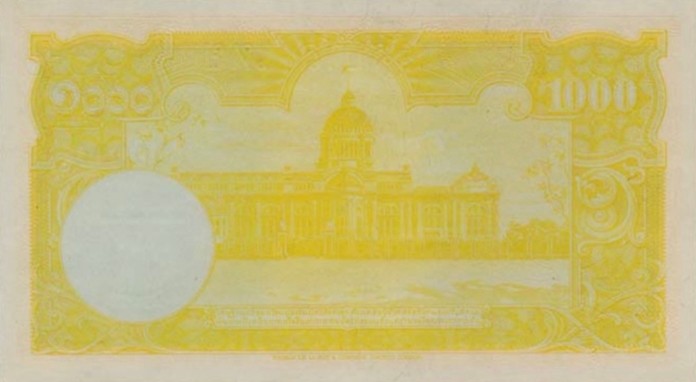

Some of the 1000 Baht notes now in the market are printed in colours not suitable to be circulated and in such large numbers not necessary as printer’s designs. They were not produced to be sent out to other National Banks, as they were never approved. The Bank of Thailand only bought the finished product, the banknotes produced for circulation. They did, however, also receive for their archives materials needed, like prints of the main front plates showing the secret marks.
For printer’s proofs and colour trials TdlR would stamp them SPECIMEN, make perforations like CANCELLED, SPECIMEN OF NO VALUE or some other form showing that the notes were not meant as legal tender. The newly appeared notes do not have any indication of being specimen notes. The Bank of Thailand could receive the notes meant for circulation without numbers and signatures as this was done in Thailand as a security measure. The Bank of Thailand did sometimes stamp specimen notes with a green SPECIMEN across and a red SPECIMEN stamp in two places.
The notes first seen on the market in 2015 are in remarkably good condition. The paper is crispy and white like newly printed banknotes. Notes have been graded by PMG, Paper Money Guaranty, to be in Choice Uncirculated condition, 64 to 66. This is very unusual for notes of this age, special if they have been printed and kept in a warm and humid country. Most of the notes from the archives of TdlR, London have traces of mounting on the reverse right side as they were glued up when kept in the archives.
Must Read: Coins of the Realm: 1000 BAHT 1949-1952 (Part 1)
| Bibliography and Sources:
The archives of Thomas de la Rue |
 |
 |
 |





